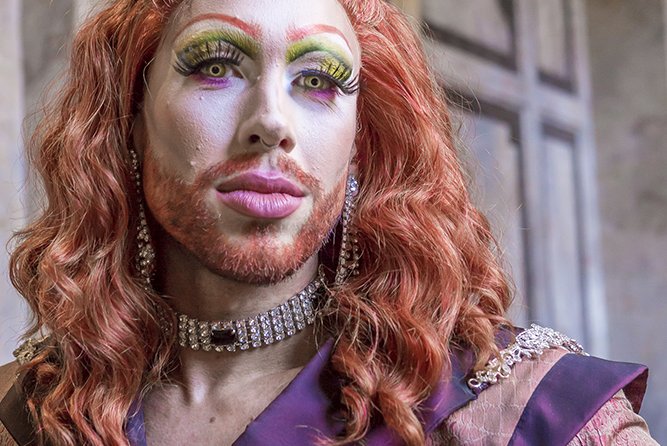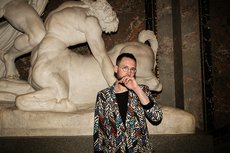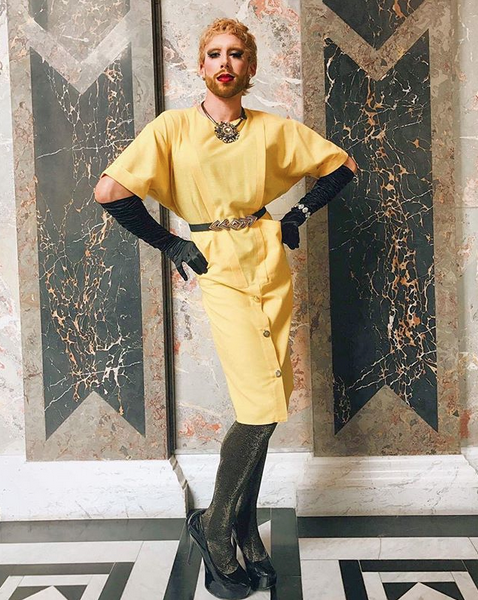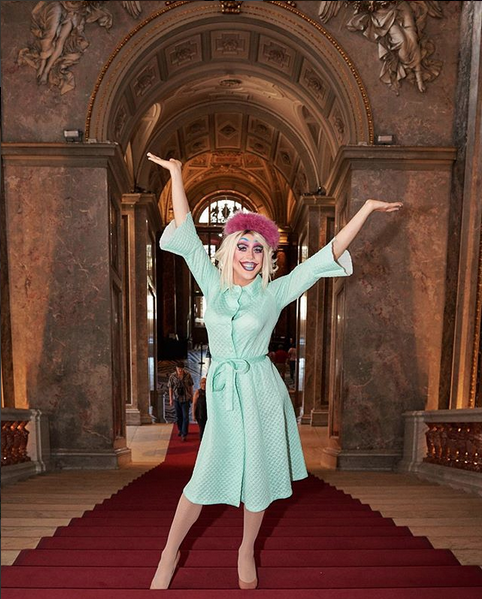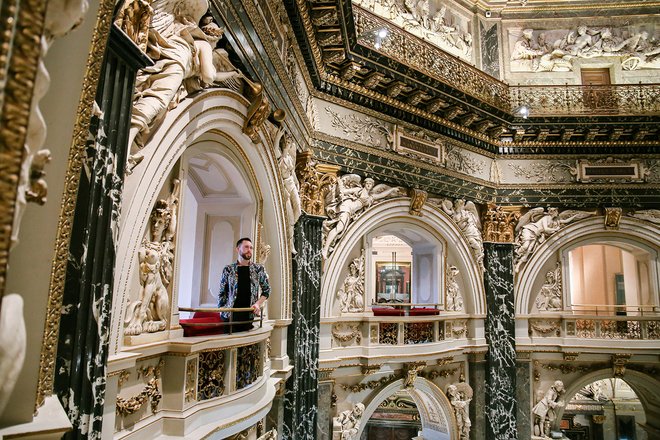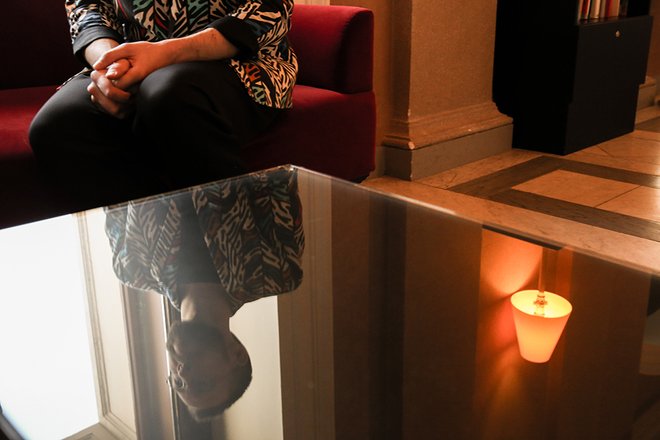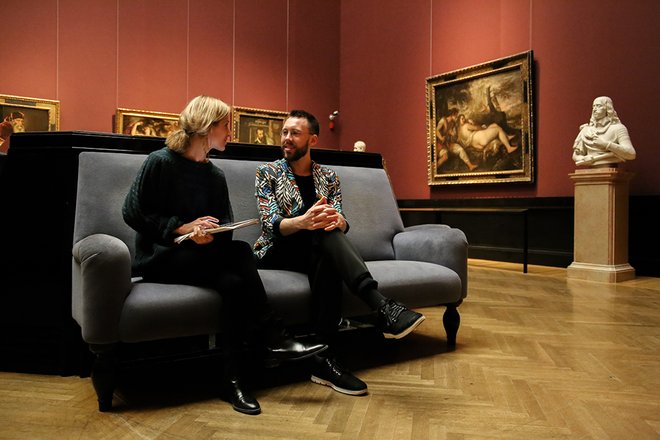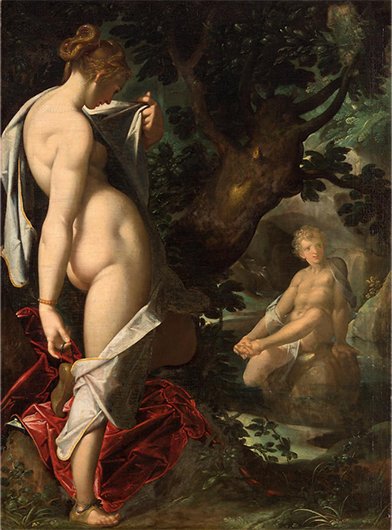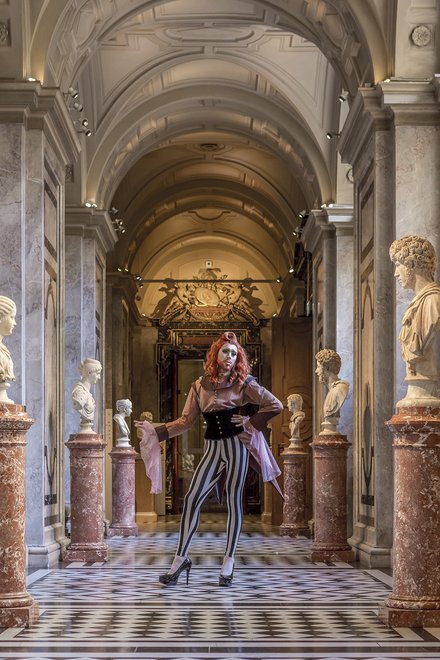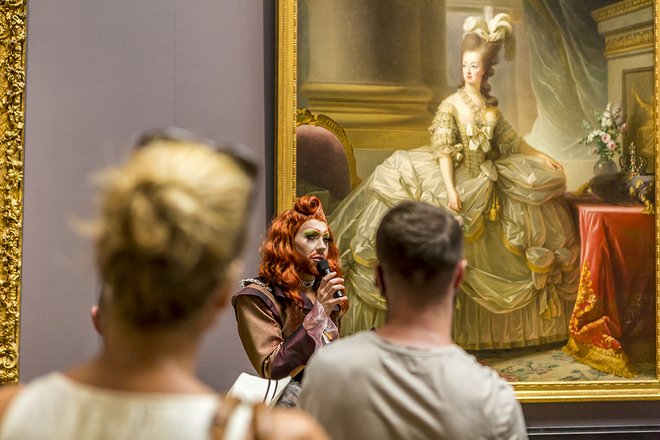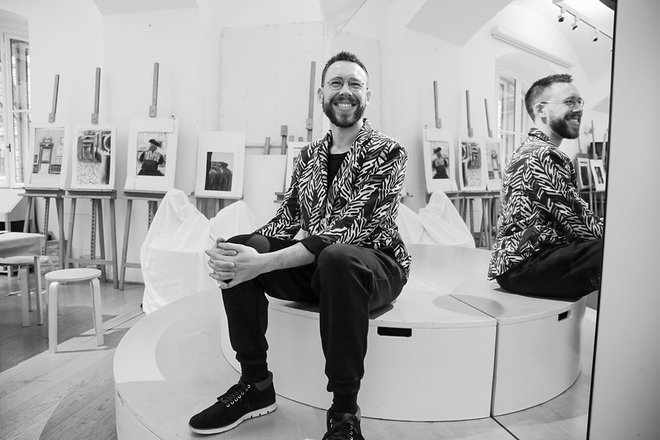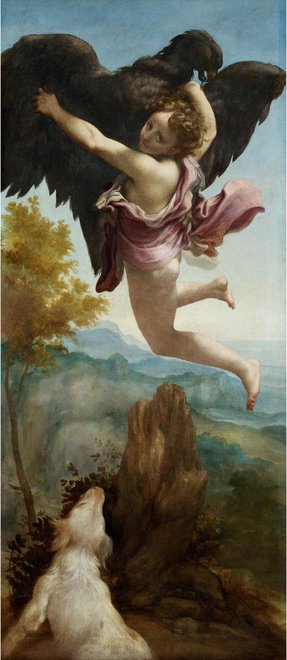Art Education Meets Lipstick
Same-sex love, transvestism, and intersexual people have always existed – also in art. Benjamin aka drag queen Tiefe Kümmernis [derived from Saint Wilgefortis] gives guided tours through the Kunsthistorisches Museum in Vienna, which provide a queer view upon masterpieces by the likes of Raphael, Correggio, and Titian. Gender bending art galore! We met Ben in one of the most solemn places in Vienna and were invited on a tour. Without make-up, wig, and tortuous high heels.
Eva Holzinger: Are you nervous before your tours through Kunsthistorisches Museum?
Benjamin: Always. But short before the start – whether it’s a tour, party or performance – I feel strong. I make use of the fact that the visitors are staring at me – I play with their attention and manipulate them to follow me wherever I want to have them. Then I can relax and feel empowered by the outfit of Tiefe Kümmernis.
"Drag is my weapon!"
How do people react to your tours?
With a smile and serious interest. My feeling is that my audience is really hanging on every word I say. I keep hearing: “That was a very special experience.” Sometimes I can accept that, but sometimes I also have doubts. Isn’t it just drag plus a museum tour? Or is it really something special?
Art history can be quite dusty and full of sexism. When I think of an art historian, a white heterosexual man comes to mind. That’s exactly what you break with and turn into something special in your tours.
That’s my main objective. A female professor in my art history studies didn’t even know what LGBT – Lesbian Gay Bisexual Transgender – means and also didn’t want to know. I want to turn this old way of thinking on its head. Drag is my weapon against the prevailing heteronormative view of art history. The queer perspective has always existed, it just needs a mouthpiece – that’s what I am trying to be.
"The museum is palatial and pompous but kind of lacks self-irony."
Isn’t the Kunsthistorisches Museum a horribly dusty institution, and is it the right place for such ideas?
The museum is palatial and pompous but kind of lacks self-irony and has long missed out on questioning itself. That’s the case with most museums. On the occasion of the 125th anniversary there was the special exhibition “Celebration!”, which was about escaping the everyday, costumes and role play, among other things. I took the chance and proposed doing a tour in drag. We tried it out and it worked so well that it got continued.
Were there concerns about having a drag queen guide visitors through the hallowed halls of the museum?
Not really. This isn’t just an act of charity for me or the queer community by the museum, it also benefits from it: The media attention is high, and so is the number of visitors. Besides my job as an art educator, I get the chance to explain people concepts like transsexuality and transvestism – and that’s extremely important in hidebound times like these.
"To explain transsexuality and transvestism is all the more important in hidebound times like these!"
Your tours always have a tongue-in-cheek twist. Is there the danger to banalize art when it is made more accessible, like by you?
It’s important that I don’t overestimate my role. Verbal interpretations of a material thing that doesn’t work on the basis of language can only live up to it to a certain degree. At the same time a mystification and artificial elevation of art is unnecessary, in my opinion. Sure, there are hundreds of years between the creation of works and their viewers here today in the museum, but that doesn’t mean that the artworks have nothing to do with contemporary society.
Please prove it to us on the example of the wonderful painting “Hermaphroditus and the Nymph Salmacis”!
The painting “Hermaphroditus and the Nymph Salmacis” is part of my tour: The nymph Salmacis falls in love with the young man Hermaphroditus and draws him down into her spring under water. She prays to the Gods that they might never be parted again. The Gods grant her request by uniting their two bodies into one. According to Ovid’s tale this is how the first hermaphrodite emerged. Hermaphrodites are indeed mythological beings, but there have always been intersexual people born with “ambiguous” sexual characteristics. So this is were mythology and everyday experience merge. In this case, however, the painter shows, in line with the spirit of his time, the moment before the unification: the classical female nude instead of the intersexual body.
You are half American, half German descent. How did you end up in the Kunsthistorisches Museum in Vienna?
I grew up in Germany and studied art history in Nuremberg. Vienna had a special appeal to me since colleagues conducted progressive art education in museums there in the 1990s. Performative elements and dialogue instead of monologs were applied. Vienna was the birthplace of modern art education in museums, so to speak. For me, everything started with an internship at the Essl Museum. I have been with the Kunsthistorisches Museum since 2016.
Do you feel at home in Vienna?
In any case. Besides the multifaceted museum scene, it is also because of the queer scene here that I feel so comfortable: It is alternative, a bit filthy, and not perfect. Like me!
"Vienna’s queer scene is alternative, a bit filthy, and not perfect. Like me!"
Why are you a drag queen?
I am not interested in giving away my face or my drag performance to a huge commercial party or company. For me, drag is neither a second-chance profession nor an escape from my boring job as an art educator (laughs). It’s more that I can live out my queer-feminist and anti-commercial ideals at small but great parties and performance formats.
What are these queer-feminist ideals, in your opinion? What does drag mean for you?
For me, drag means a playful deconstruction of gender roles and opening up new scopes of action. As a male, who likes art, is sensitive, and a little bit vain I don’t want to represent a peripheral aspect but a common facet of masculinity. In drag I not only search for my female characteristics but also for a certain camaraderie between me and women. Isn’t it totally impossible to be a woman? She should be attractive but not too sexy. Sensitive but not a sissy. With some perseverance and power but naturally not too much! With drag you can question this framework and break it open.
How long does it take to transform into Tiefe Kümmernis? And who is she?
Externally, the transformation starts with shaving, then it goes on with gluing, primer, foundation, make-up, and so on; this can take up to four hours – also just to name everything, by the way! (laughs) Tiefe Kümmernis is actually not so different than Benjamin. After all, I didn’t design her on the drafting table. She is a mixture of courage and humor, and a self-confident person. All in all, she is a more shiny version of myself. One thing I have to remark: Being a drag queen is expensive…
"Clean out the dishwasher in high heels!"
… and painful, isn’t it?
You bet! During a several-hour shoot or other actions it can very well happen that I have to take a lot of painkillers to keep going. Once my feet were full of bloody blisters. It took days for me to recover.
One tip, please: How can you learn to walk in high heels?
Wear them at home. Work at the computer, eat while wearing them. Step two: household activities. Clean out the dishwasher in high heels! In this way you get used to the high heels step by step, and they become a matter of course. The height: asphalt and cobblestone pavement. Nothing in the world can prepare you for that.
"Conchita wasn’t the first bearded woman in history!"
The name “Tiefe Kümmernis” is very unusual for a drag queen. We are more used to shrill or funny ones like Lady Bunny or Pussy Tourette!
Yes, the name has its roots where one makes perhaps the least connection to a drag queen: in the Catholic folk religion of the Middle Ages. The legend tells the story of a bearded woman. So Conchita was not the first one! A king wants her daughter to marry. She is reluctant and prays to God to change her so that no man has any interest in her anymore. Thereupon she grows a beard overnight. The king is furious and has her crucified as a punishment. In this story the beard represents a protective shield to preserve the virginity of the princess and thereby her self-determination. “Die tiefe Kümmernis” is my personal adaptation of this message.
Why are there so few drag kings, actually?
In our society to be female means to be beautiful, an artificial ideal, there’s almost something theatrical about it. Masculinity, on the other hand, supposedly stands for something down to earth, inconspicuous, natural. This makes masculinity harder to question, as it pretends to be authentic. Nevertheless, it is equally a code, a convention of behaviors and appearance. On this basis, it is far easier to exaggerate femininity and still keep references.
We are standing in front of a wonderful Titian! The famous portrait of Isabelle d’Este. What can you tell us about it?
Isabelle d’Este was one of the most important figures in culture and politics of the Italian Renaissance. She had this portrait made when she was already almost fifty years old, but on the painting she looks not any older than twenty. This is because she sent the painter a picture from her youth, together with a perfectly filigreed description of her look and character. So it is more an ideal image than a portrait. Isabella was a wise and very popular monarch, known for her will power and support for the arts and sciences. A kind of proto-feminist from 500 years ago. But in contrast she is also an example for vanity, unhappiness with one’s own appearance, the desire for idealization. I quite like this contradiction. And the question remains eternally: What did she really look like?
But aren’t we like Isabella d’Este when we post selfies on Instagram, after applying filter over filter, when we perfect ourselves and hide who is really behind the photos?
That’s true. I find this possibility to create yourself an extremely interesting and sometimes great thing. I can control how I want to be perceived. But time and again I also feel disgusted by social media: Everything’s fake! Even drag then seems absurd to me, as it is self-presentation par excellence and a totally consumerist practice to boot. You always have to buy new outfits. That’s not me, actually. But then there are other aspects of drag I like very much, so I continue.
We end our interview in front of Correggio’s famous work “Ganymede Abducted by the Eagle”. What a great painting!
In this picture, the abduction of Ganymede takes place in mutual consent. Other artists have depicted it more violently. But should a painting be read as an epitome of queerness when there is violence, kidnapping, or even pedophilia involved? It depends on the interpretation, whether one considers it as an act of violence or not. The age of sexual consent, for example, is a socially negotiated aspect and was seen differently back then. It is very difficult to relate it to modern times and come to a definite judgment. Such unresolvable contradictions are an important part of my tours.
But one thing I want to mention: The painting is one of my favorites, it is wonderfully composed. Art doesn’t always need to be read on an intellectual, political, or social level: Sometimes it can simply just be beautiful.
"The eagle licks the wrist of the young man: a reference to homosexual love and attraction."
Thank you very much for the wonderful afternoon and the conversation!

